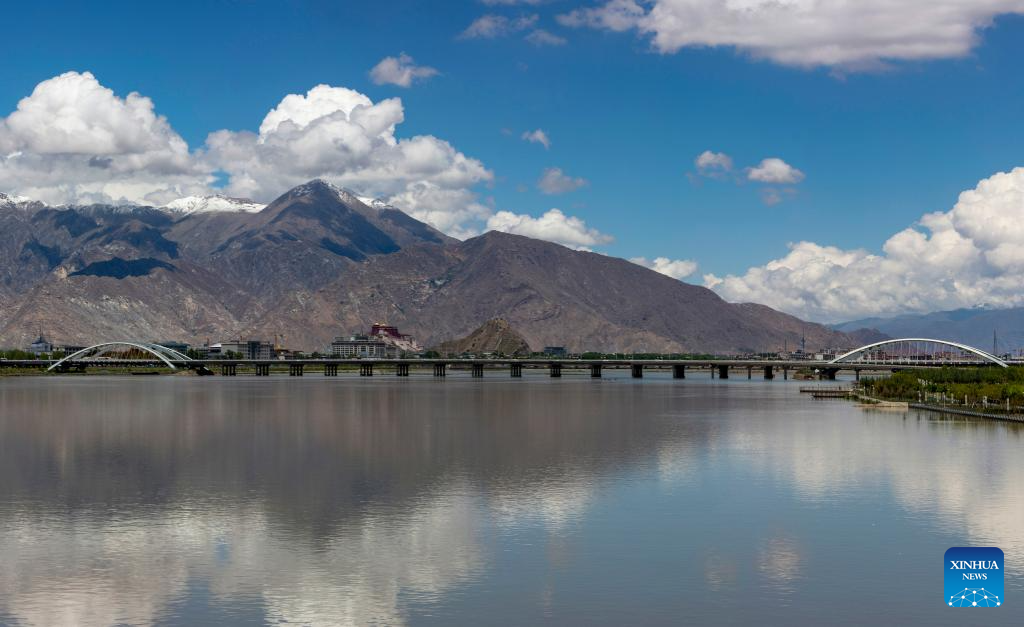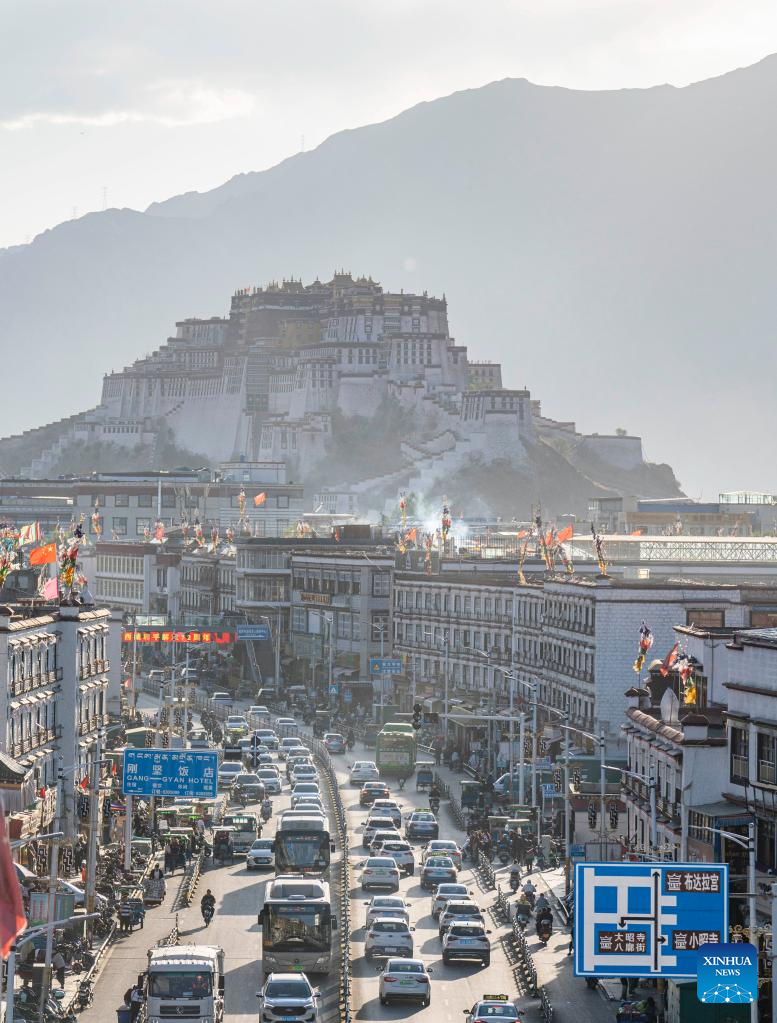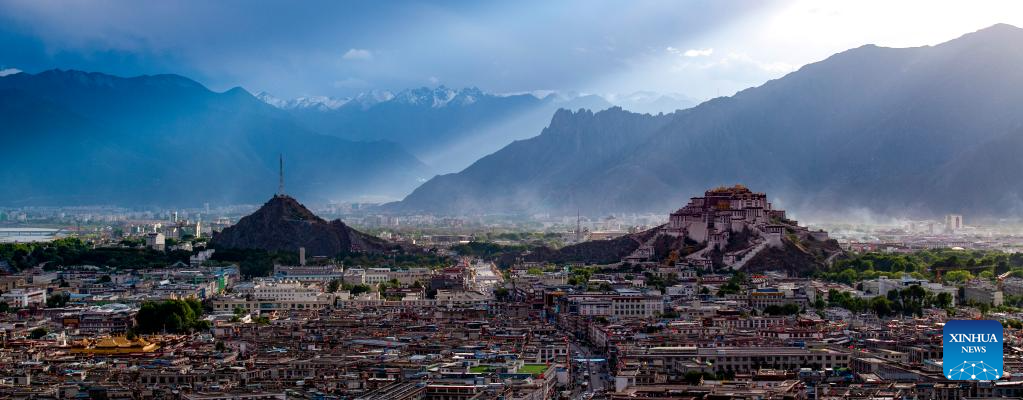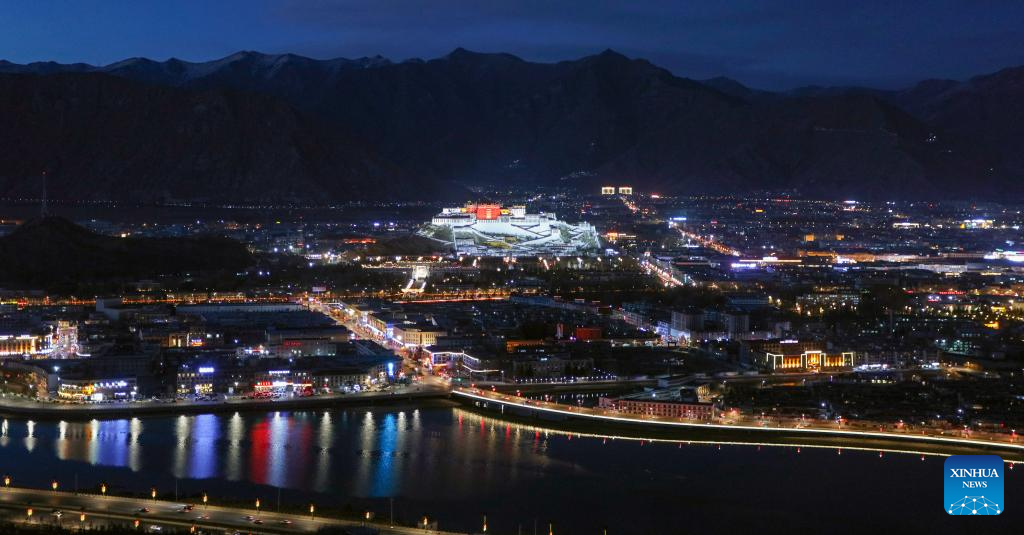
Traffics are seen in a street in Lhasa, capital of southwest China's Tibet Autonomous Region, June 15, 2023, Since the 7th century, the city of Lhasa gradually emerged in the heart of the plateau, nestled within the valley of the Lhasa River -- a tributary of the Yarlung Tsangpo River.
The city's rich history spans centuries, characterized by layers of cultural heritage, thereby fostering a distinctive plateau culture that embraces diversity and inclusiveness.
This remarkable plateau culture exemplifies the enduring vibrancy of Chinese cultural heritage, resonating with people around the world. (Xinhua/Sun Fei)

The Liuwu Bridge is seen over the Lhasa River in Lhasa, capital of southwest China's Tibet Autonomous Region, June 15, 2023. Since the 7th century, the city of Lhasa gradually emerged in the heart of the plateau, nestled within the valley of the Lhasa River -- a tributary of the Yarlung Tsangpo River.
The city's rich history spans centuries, characterized by layers of cultural heritage, thereby fostering a distinctive plateau culture that embraces diversity and inclusiveness.
This remarkable plateau culture exemplifies the enduring vibrancy of Chinese cultural heritage, resonating with people around the world. (Xinhua/Jiang Fan)

Traffics are seen at the foot of the Potala Palace in Lhasa, capital of southwest China's Tibet Autonomous Region, June 7, 2023. Since the 7th century, the city of Lhasa gradually emerged in the heart of the plateau, nestled within the valley of the Lhasa River -- a tributary of the Yarlung Tsangpo River.
The city's rich history spans centuries, characterized by layers of cultural heritage, thereby fostering a distinctive plateau culture that embraces diversity and inclusiveness.
This remarkable plateau culture exemplifies the enduring vibrancy of Chinese cultural heritage, resonating with people around the world. (Xinhua/Sun Fei)

This aerial photo taken on March 30, 2023 shows the south ring road in Lhasa, capital of southwest China's Tibet Autonomous Region. Since the 7th century, the city of Lhasa gradually emerged in the heart of the plateau, nestled within the valley of the Lhasa River -- a tributary of the Yarlung Tsangpo River.
The city's rich history spans centuries, characterized by layers of cultural heritage, thereby fostering a distinctive plateau culture that embraces diversity and inclusiveness.
This remarkable plateau culture exemplifies the enduring vibrancy of Chinese cultural heritage, resonating with people around the world. (Xinhua/Sun Fei)

Youngsters attend a live concert in Lhasa, capital of southwest China's Tibet Autonomous Region, July 29, 2022. Since the 7th century, the city of Lhasa gradually emerged in the heart of the plateau, nestled within the valley of the Lhasa River -- a tributary of the Yarlung Tsangpo River.
The city's rich history spans centuries, characterized by layers of cultural heritage, thereby fostering a distinctive plateau culture that embraces diversity and inclusiveness.
This remarkable plateau culture exemplifies the enduring vibrancy of Chinese cultural heritage, resonating with people around the world. (Xinhua/Jigme Dorje)

The sunshine is shed on the Potala Palace in Lhasa, capital of southwest China's Tibet Autonomous Region, June 15, 2023. Since the 7th century, the city of Lhasa gradually emerged in the heart of the plateau, nestled within the valley of the Lhasa River -- a tributary of the Yarlung Tsangpo River.
The city's rich history spans centuries, characterized by layers of cultural heritage, thereby fostering a distinctive plateau culture that embraces diversity and inclusiveness.
This remarkable plateau culture exemplifies the enduring vibrancy of Chinese cultural heritage, resonating with people around the world. (Xinhua/Jiang Fan)

A hotel transformed from an ancient building is seen in Lhasa, capital of southwest China's Tibet Autonomous Region, March 24, 2023. Since the 7th century, the city of Lhasa gradually emerged in the heart of the plateau, nestled within the valley of the Lhasa River -- a tributary of the Yarlung Tsangpo River.
The city's rich history spans centuries, characterized by layers of cultural heritage, thereby fostering a distinctive plateau culture that embraces diversity and inclusiveness.
This remarkable plateau culture exemplifies the enduring vibrancy of Chinese cultural heritage, resonating with people around the world. (Xinhua/Jigme Dorje)

A man plays the guitar in front of the Princess Wencheng Theatre in Lhasa, capital of southwest China's Tibet Autonomous Region, June 6, 2023. Since the 7th century, the city of Lhasa gradually emerged in the heart of the plateau, nestled within the valley of the Lhasa River -- a tributary of the Yarlung Tsangpo River.
The city's rich history spans centuries, characterized by layers of cultural heritage, thereby fostering a distinctive plateau culture that embraces diversity and inclusiveness.
This remarkable plateau culture exemplifies the enduring vibrancy of Chinese cultural heritage, resonating with people around the world. (Xinhua/Sun Fei)

A "Fuxing" high-speed train is seen at a preparedness center in Lhasa, capital of southwest China's Tibet Autonomous Region, Jan. 11, 2023. Since the 7th century, the city of Lhasa gradually emerged in the heart of the plateau, nestled within the valley of the Lhasa River -- a tributary of the Yarlung Tsangpo River.
The city's rich history spans centuries, characterized by layers of cultural heritage, thereby fostering a distinctive plateau culture that embraces diversity and inclusiveness.
This remarkable plateau culture exemplifies the enduring vibrancy of Chinese cultural heritage, resonating with people around the world. (Xinhua/Sun Fei)

This photo taken on March 2, 2022 shows the night view of Lhasa, capital of southwest China's Tibet Autonomous Region. Since the 7th century, the city of Lhasa gradually emerged in the heart of the plateau, nestled within the valley of the Lhasa River -- a tributary of the Yarlung Tsangpo River.
The city's rich history spans centuries, characterized by layers of cultural heritage, thereby fostering a distinctive plateau culture that embraces diversity and inclusiveness.
This remarkable plateau culture exemplifies the enduring vibrancy of Chinese cultural heritage, resonating with people around the world. (Xinhua/Jiang Fan)

People pose for a photo on the square of the Potala Palace in Lhasa, capital of southwest China's Tibet Autonomous Region, June 16, 2023. Since the 7th century, the city of Lhasa gradually emerged in the heart of the plateau, nestled within the valley of the Lhasa River -- a tributary of the Yarlung Tsangpo River.
The city's rich history spans centuries, characterized by layers of cultural heritage, thereby fostering a distinctive plateau culture that embraces diversity and inclusiveness.
This remarkable plateau culture exemplifies the enduring vibrancy of Chinese cultural heritage, resonating with people around the world. (Xinhua/Zhang Rufeng)

A marriage proposal is held on the roof of a restaurant in Lhasa, capital of southwest China's Tibet Autonomous Region, June 7, 2023. Since the 7th century, the city of Lhasa gradually emerged in the heart of the plateau, nestled within the valley of the Lhasa River -- a tributary of the Yarlung Tsangpo River.
The city's rich history spans centuries, characterized by layers of cultural heritage, thereby fostering a distinctive plateau culture that embraces diversity and inclusiveness.
This remarkable plateau culture exemplifies the enduring vibrancy of Chinese cultural heritage, resonating with people around the world. (Xinhua/Sun Fei)

People perform Guozhuang, a bonfire dance of Tibetans, at a park in Lhasa, capital of southwest China's Tibet Autonomous Region, June 14, 2023. Since the 7th century, the city of Lhasa gradually emerged in the heart of the plateau, nestled within the valley of the Lhasa River -- a tributary of the Yarlung Tsangpo River.
The city's rich history spans centuries, characterized by layers of cultural heritage, thereby fostering a distinctive plateau culture that embraces diversity and inclusiveness.
This remarkable plateau culture exemplifies the enduring vibrancy of Chinese cultural heritage, resonating with people around the world. (Xinhua/Sun Fei)

Youngsters attend a live concert in Lhasa, capital of southwest China's Tibet Autonomous Region, July 29, 2022. Since the 7th century, the city of Lhasa gradually emerged in the heart of the plateau, nestled within the valley of the Lhasa River -- a tributary of the Yarlung Tsangpo River.
The city's rich history spans centuries, characterized by layers of cultural heritage, thereby fostering a distinctive plateau culture that embraces diversity and inclusiveness.
This remarkable plateau culture exemplifies the enduring vibrancy of Chinese cultural heritage, resonating with people around the world. (Xinhua/Jigme Dorje)

This aerial panoramic photo taken on March 30, 2023 shows a view of the Lhasa City in southwest China's Tibet Autonomous Region. Since the 7th century, the city of Lhasa gradually emerged in the heart of the plateau, nestled within the valley of the Lhasa River -- a tributary of the Yarlung Tsangpo River.
The city's rich history spans centuries, characterized by layers of cultural heritage, thereby fostering a distinctive plateau culture that embraces diversity and inclusiveness.
This remarkable plateau culture exemplifies the enduring vibrancy of Chinese cultural heritage, resonating with people around the world. (Xinhua/Sun Fei)

People perform Guozhuang, a bonfire dance of Tibetans, at a park in Lhasa, capital of southwest China's Tibet Autonomous Region, June 14, 2023. Since the 7th century, the city of Lhasa gradually emerged in the heart of the plateau, nestled within the valley of the Lhasa River -- a tributary of the Yarlung Tsangpo River.
The city's rich history spans centuries, characterized by layers of cultural heritage, thereby fostering a distinctive plateau culture that embraces diversity and inclusiveness.
This remarkable plateau culture exemplifies the enduring vibrancy of Chinese cultural heritage, resonating with people around the world. (Xinhua/Jiang Fan)

The outdoor musical "Princess Wencheng" is staged in Lhasa, capital of southwest China's Tibet Autonomous Region, June 15, 2023. Since the 7th century, the city of Lhasa gradually emerged in the heart of the plateau, nestled within the valley of the Lhasa River -- a tributary of the Yarlung Tsangpo River.
The city's rich history spans centuries, characterized by layers of cultural heritage, thereby fostering a distinctive plateau culture that embraces diversity and inclusiveness.
This remarkable plateau culture exemplifies the enduring vibrancy of Chinese cultural heritage, resonating with people around the world. (Xinhua/Sun Fei)

A yogurt store is seen near the Potala Palace in Lhasa, capital of southwest China's Tibet Autonomous Region, June 16, 2023. Since the 7th century, the city of Lhasa gradually emerged in the heart of the plateau, nestled within the valley of the Lhasa River -- a tributary of the Yarlung Tsangpo River.
The city's rich history spans centuries, characterized by layers of cultural heritage, thereby fostering a distinctive plateau culture that embraces diversity and inclusiveness.
This remarkable plateau culture exemplifies the enduring vibrancy of Chinese cultural heritage, resonating with people around the world. (Xinhua/Zhang Rufeng)

People select clothes at a Tibetan-style fashion store in Lhasa, capital of southwest China's Tibet Autonomous Region, June 18, 2023. Since the 7th century, the city of Lhasa gradually emerged in the heart of the plateau, nestled within the valley of the Lhasa River -- a tributary of the Yarlung Tsangpo River.
The city's rich history spans centuries, characterized by layers of cultural heritage, thereby fostering a distinctive plateau culture that embraces diversity and inclusiveness.
This remarkable plateau culture exemplifies the enduring vibrancy of Chinese cultural heritage, resonating with people around the world. (Xinhua/Sun Fei)

This photo taken on June 7, 2023 shows the Potala Palace at sunrise in Lhasa, capital of southwest China's Tibet Autonomous Region. Since the 7th century, the city of Lhasa gradually emerged in the heart of the plateau, nestled within the valley of the Lhasa River -- a tributary of the Yarlung Tsangpo River.
The city's rich history spans centuries, characterized by layers of cultural heritage, thereby fostering a distinctive plateau culture that embraces diversity and inclusiveness.
This remarkable plateau culture exemplifies the enduring vibrancy of Chinese cultural heritage, resonating with people around the world. (Xinhua/Sun Fei)



